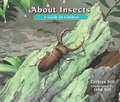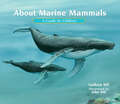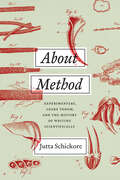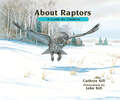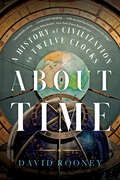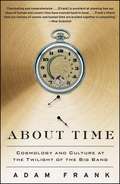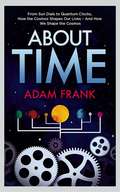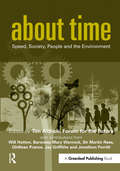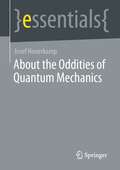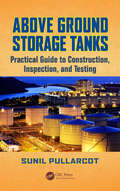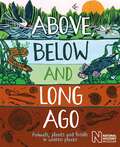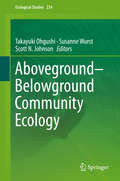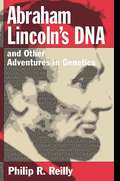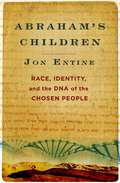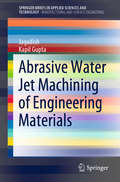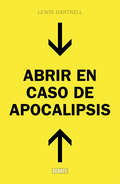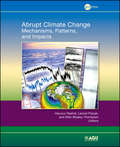- Table View
- List View
About Insects: A Guide for Children (About. . . #4)
by Cathryn SillThis beginner's guide to insects is a must-have for bug-obsessed young learners as well as for those who are simply curious about these creatures. In this addition to the acclaimed About... series, author and educator Cathryn Sill uses simple, easy-to-understand language to teach children what insects are, how they look, how they move, what they eat, and where they live. With beautifully detailed, realistic paintings, noted wildlife illustrator John Sill introduces readers to a wide variety of insects, from ants and beetles to grasshoppers and the monarch butterfly. An afterword provides further details, inspiring young readers to learn more.
About Mammals / Sobre los mamíferos: A Guide for Children / Una guía para niños (About. . . #15)
by Cathryn SillAn award-winning first glimpse into the diverse natural world of mammals.This addition to the acclaimed About... series explains to children in simple, easy-to-understand language what mammals are, what they eat, and where they live. Beautifully detailed, realistic paintings by wildlife illustrator John Sill introduce readers to the huge variety of mammals, from the tiny white-footed deermouse to the large American bison. An afterword provides more details about the animals featured in the book. Parents and pre-school and primary-grade teachers will find this an attractive choice for introducing kids to mammals.
About Mammals: A Guide for Children (About. . . #2)
by Cathryn SillAn award-winning first glimpse into the diverse natural world of mammals.This addition to the acclaimed About... series explains to children in simple, easy-to-understand language what mammals are, what they eat, and where they live. Beautifully detailed, realistic paintings by wildlife illustrator John Sill introduce readers to the huge variety of mammals, from the tiny white-footed deermouse to the large American bison. An afterword provides more details about the animals featured in the book. Parents and pre-school and primary-grade teachers will find this an attractive choice for introducing kids to mammals.
About Marine Mammals: A Guide for Children (About. . . #19)
by Cathryn SillA classroom favorite, this book provides a first glimpse of marine mammals that's ideal for budding oceanographers!In this beginner's guide, author and educator Cathryn Sill simply and clearly shows children what is essential for understanding and appreciating marine mammals—how they look, how they move, what they eat, and where they live. She covers animals as diverse as whales and otters to dolphins, polar bears, and more. The beautifully detailed, realistic paintings of noted wildlife illustrator John Sill depict a variety of marine mammals. An afterword provides more details for further exploration.
About Method: Experimenters, Snake Venom, and the History of Writing Scientifically
by Jutta SchickoreScientists’ views on what makes an experiment successful have developed dramatically throughout history. Different criteria for proper experimentation were privileged at different times, entirely new criteria for securing experimental results emerged, and the meaning of commitment to experimentation altered. In About Method, Schickore captures this complex trajectory of change from 1660 to the twentieth century through the history of snake venom research. As experiments with poisonous snakes and venom were both challenging and controversial, the experimenters produced very detailed accounts of their investigations, which go back three hundred years—making venom research uniquely suited for such a long-term study. By analyzing key episodes in the transformation of venom research, Schickore is able to draw out the factors that have shaped methods discourse in science. About Method shows that methodological advancement throughout history has not been simply a steady progression toward better, more sophisticated and improved methodologies of experimentation. Rather, it was a progression in awareness of the obstacles and limitations that scientists face in developing strategies to probe the myriad unknown complexities of nature. The first long-term history of this development and of snake venom research, About Method offers a major contribution to integrated history and philosophy of science.
About Parrots: A Guide for Children (About. . . #16)
by Cathryn SillA beautiful, informative first glance at the world of parrots.In this addition to the acclaimed About... series, author and educator Cathryn Sill uses simple, easy-to-understand language to teach children what parrots are, what they do, and how they live. With beautifully detailed, realistic paintings, noted wildlife illustrator John Sill introduces readers to the diverse population of parrots—from the colorful blue lorikeets of the Polynesian Islands to the rosy-faced lovebirds of southwestern Africa. An afterword provides more details for further exploration.
About Raptors: A Guide for Children (About. . . #13)
by Cathryn SillBudding birders will enjoy finding out about birds of prey in this award-winning first guide from the creators of the celebrated About... series.This beginner's guide uses simple, easy-to-understand language to teach children what raptors are, how they look, how they move, what they eat, and where they live. The beautifully detailed, realistic paintings of noted wildlife illustrator John Sill introduce readers to many varieties of raptors around the world, from the majestic bald eagle of North America to the sharp-eyed secretary bird of Africa. An afterword provides more information for eager young learners. Ideal for casual exploration as well as for early childhood and elementary science units on animals.
About Time: A Children's Guide to the History and Science of Time
by Alom Shaha Rebecca StruthersA children’s guide to the science and history of telling the time and clockmaking in a fun and interactive way.This interactive book will help children aged 7-9 understand how clocks work and learn how to tell the time on various devices.Time is central to our experience as humans, and it’s important for children to know not just how to tell the time, but also how to make the most of it. About Time uses fun and unique elements to teach children about the topic of time and introduce concepts like time zones and time management.This time book for children offers:Content written by experts in the field, a scientist, and a Horologist (the study of time).A unique book on an underrepresented topic, looking at how humans learned to measure time, how it shapes our lives, and the amazing science behind time.Interactive and practical activities for children to get involved with and learn about the subject.This book combines the expertise of an award-winning watchmaker and a physics teacher to explore the mechanics and history of timekeeping while aligning with the national curriculum. With this book children can learn much more than just how to tell the time, they can also find out how clocks are built and even explore the history behind timekeeping.
About Time: A History Of Civilization In Twelve Clocks
by David RooneyA captivating, surprising history of timekeeping and how it has shaped our world. For thousands of years, people of all cultures have made and used clocks, from the city sundials of ancient Rome to the medieval water clocks of imperial China, hourglasses fomenting revolution in the Middle Ages, the Stock Exchange clock of Amsterdam in 1611, Enlightenment observatories in India, and the high-precision clocks circling the Earth on a fleet of GPS satellites that have been launched since 1978. Clocks have helped us navigate the world and build empires, and have even taken us to the brink of destruction. Elites have used them to wield power, make money, govern citizens, and control lives—and sometimes the people have used them to fight back. Through the stories of twelve clocks, About Time brings pivotal moments from the past vividly to life. Historian and lifelong clock enthusiast David Rooney takes us from the unveiling of al-Jazari’s castle clock in 1206, in present-day Turkey; to the Cape of Good Hope observatory at the southern tip of Africa, where nineteenth-century British government astronomers moved the gears of empire with a time ball and a gun; to the burial of a plutonium clock now sealed beneath a public park in Osaka, where it will keep time for 5,000 years. Rooney shows, through these artifacts, how time has been imagined, politicized, and weaponized over the centuries—and how it might bring peace. Ultimately, he writes, the technical history of horology is only the start of the story. A history of clocks is a history of civilization.
About Time: Cosmology and Culture at the Twilight of the Big Bang
by Adam FrankThe Big Bang is all but dead, and we do not yet know what will replace it. Our universe’s “beginning” is at an end. What does this have to do with us here on Earth? Our lives are about to be dramatically shaken again—as altered as they were with the invention of the clock, the steam engine, the railroad, the radio and the Internet. In The End of the Beginning, Adam Frank explains how the texture of our lives changes along with our understanding of the universe’s origin. Since we awoke to self-consciousness fifty thousand years ago, our lived experience of time—from hunting and gathering to the development of agriculture to the industrial revolution to the invention of Outlook calendars—has been transformed and rebuilt many times. But the latest theories in cosmology— time with no beginning, parallel universes, eternal inflation—are about to send us in a new direction. Time is both our grandest and most intimate conception of the universe. Many books tell the story, recounting the progress of scientific cosmology. Frank tells the story of humanity’s deepest question— when and how did everything begin?—alongside the story of how human beings have experienced time. He looks at the way our engagement with the world— our inventions, our habits and more—has allowed us to discover the nature of the universe and how those discoveries, in turn, inform our daily experience. This astounding book will change the way we think about time and how it affects our lives.
About Time: From Sun Dials to Quantum Clocks, How the Cosmos Shapes our Lives - And We Shape the Cosmos
by Adam FrankFrom Stonehenge to beyond the Big Bang, an exhilarating scientific exploration of how we make time Time is the grandest conception of the universe that we humans have been able to imagine - and its most intimate, the very frame of human life. In About Time, astrophysicist and award-winning writer Adam Frank tells the scientific story of this wonderful and tyrannical invention. A Palaeolithic farmer moved through the sun-fuelled day and star-steered night in a radically different way than the Elizabethan merchants who set their pace to the clocks newly installed in their town squares. Since then, science has swept time into increasingly minute and standardized units - the industrial efficiency of ironworks' punch clocks; the space-age precision of atomic fountains and GPS satellites; the fifteen-minute increments of Outlook's digital revolution. And in the past decade, string-theory branes, multiverses, and "clockless" physics have begun to overturn our ideas about how the universe began - the Big Bang - in ways that will completely rewrite time and our experience of it. Weaving cosmology with day-to-day chronicles and a down-to-earth style, About Time is both dazzling and riveting as it confronts what comes next.
About Time: Speed, Society, People and the Environment
by Martin Rees Will Hutton Mary Warnock Geoff Mulgan Jay Griffiths Jonathon Porritt David Boyle Alexandra Jones Ghillean Prance Tim AldrichWhere does all the time go? Despite the burgeoning army of machines designed to save us time – from cars and aeroplanes to dishwashers and microwaves – we don't seem to have any more of it on our hands. We simply fill the space we clear with more things to do – consuming more, spending more – and then look around for new ways of saving time. And so we spiral onwards, upwards, ever faster. Being busy has become a habit, and a habit that gives us high status – busy people are important people. The business of business is busy-ness. We are moving from a world in which the big eats the small, to a world where the fast eats the slow. But the fallout from a society hooked on speed is everywhere. It's affecting our health: 60 per cent of the adult population in the UK report that they suffer from stress, and more than half of these say that this has worsened over the last 12 months. It's affecting our family life, with a quarter of British families sharing a meal together only once a month. And it affects our environment too: air travel is a major source of carbon dioxide emissions, accelerating climate change as we speed around the world. And the faster we live, the faster we consume, the faster we waste energy and the faster we pollute the planet. The faster we seem to be running out of time. Is there something fundamentally wrong with the structure and values of this high-speed society? What are we running from and what are we running towards? Sustainable development is all about time. It's about trying to safeguard the health of the planet, and the people it supports, indefinitely, unconstrained by time. The idea of time offers a novel perspective on what sustainable development is all about. Looking at issues affecting society and the environment through the prism of time conveys the urgency of the challenge and leads us to solutions we might not have thought of before. About Time, edited by the think-tank Forum for the Future, brings together ten of the world's leading thinkers and writers, including Will Hutton, Baroness Mary Warnock, Sir Martin Rees, Ghillean Prance, Jay Griffiths (the author of the bestselling Pip Pip) and Jonathon Porritt, from disciplines including biology, business, sociology, ethnography, astronomy, philosophy, politics, history and sustainability in a collection of intriguing essays exploring the issue of time and how it relates to the environment, economy and society. The first half of this collection looks at different dimensions of time – from the history of time as a social phenomenon and cultural notions of time, to cosmological time and the difference between human and machine time. These "think-pieces" are followed by a series of more practical, solutions-oriented contributions, looking at how we deal with time in different contexts – from the slow food movement and time banks to long-term thinking in politics and what we can individually do to cope with the speed society. Contributions are liberally interspersed with boxes and brief pieces offering bite-sized facts, figures and insights relating to time and our everyday lives. About Time is a high-profile collection aimed at creating debate about where the values of our contemporary society are taking us. It will foster reflective thinking about different aspects of time, using the concept of time to communicate and illuminate the idea of sustainable development and question our idolatry of speed. In doing so, it aims to inspire and help decision-makers in business, government and elsewhere to appreciate the challenges of sustainable development, and inspire individuals to create change in their own lives. For readers of No Logo and Longitude, this book provides a thought-provoking twist, bringing together time and sustainability in a refreshing, provocative and accessible way.
About the Oddities of Quantum Mechanics (essentials)
by Josef HonerkampQuantum mechanics is a physical theory for objects of the microcosm, e.g. for atoms or electrons. It has proven itself so far, but leads to the fact that we have to grant properties and relations to these objects, which are neither compatible with our common sense nor with the concepts of classical physics. These peculiarities are presented and their meaning for our cognitive faculty and for a world view is discussed.This Springer essential is a translation of the original German 1st edition essentials, Über die Merkwürdigkeiten der Quantenmechanik by Josef Honerkamp, published by Springer Fachmedien Wiesbaden GmbH, part of Springer Nature in 2020. The translation was done with the help of artificial intelligence (machine translation by the service DeepL.com). A subsequent human revision was done primarily in terms of content, so that the book will read stylistically differently from a conventional translation. Springer Nature works continuously to further the development of tools for the production of books and on the related technologies to support the authors.
About-Face Space Race (AstroKids #5)
by Robert ElmerFun and funny, this book will make even reluctant readers eager to turn the pages. When a space scooter race becomes a battle between the boys and girls, who will step in and remind the AstroKids to work as a team?
Above Ground Storage Tanks: Practical Guide to Construction, Inspection, and Testing
by Sunil PullarcotCovers All Site Activities after DesignAbove Ground Storage Tanks: Practical Guide to Construction, Inspection, and Testing is an ideal guide for engineers involved in the mechanical construction of above ground storage tanks. This text details the construction of storage tanks in accordance with the American Petroleum Institute requirements for AP
Above and Beyond: NASA's Journey to Tomorrow
by Discovery Olugbemisola Rhuday-PerkovichSince NASA was established in 1958, it has landed rovers on distant planets and launched telescopes deep into space—all so that we can look back to the beginning of time. <P><P> Through stunning images provided by NASA and fascinating profiles and sidebars of lesser known contributors to the NASA program, young space fans will learn how NASA started, how it faced challenges along the way, how much it has achieved, and how it will continue to move forward in the future. <P> NASA’s boundless curiosity and urge to explore lies at the heart of the human adventure. NASA rises to the urgent challenges we face, using its massive reach and expertise to find answers to vital questions like: How can we learn to live in a more extreme natural environment? <P> Inspired by Rory Kennedy’s documentary of the same name (airing 10/2018), Above and Beyond aims to leave audiences hopeful and inspired about the future of our planet—and convinced that NASA is essential to our continued survival as we mark its important anniversaries and dream of new discoveries to come.
Above the Line: Living and Leading with Heart
by Stephen Klemich Mara KlemichA leadership consultant and neuropsychologist identify the universal habits of the heart and mind—the keys to unlocking our true potential, creating our best selves and eliminating behavior patterns that hold us back. Why is it so hard for leaders to coach employees who are struggling? Why do we repeat the same mistakes and negative behaviors? Common wisdom says you always have a choice in how you react or respond. But, as corporate consultant Stephen Klemich and clinical psychologist Mara Klemich contend, until you recognize why you make choices, and how the heart and the brain work together to shape your behavior, you can’t change long-ingrained patterns and discover your best self.The Klemichs have developed a model backed by extensive research and data, and paired it with character-led personal development, to help you answer the "Why?" and eliminate behavior that is “below the line.” In Above the Line, they argue that that the quality of your life flows from the attitudes of your heart. Offering wise, compassionate, and practical advice, this book explores the deep, fundamental drivers of human behavior that exist within your heart—the seat of your character. It reveals that all of these behaviors can be explained by four principles—humility, love, pride, and fear—which influence every facet of your life, for better or for worse.We are all designed for greatness, but so often our best self is pitted against our worst. The pressures of life are pulling our character below the line while our authentic self is drawing us to live above the line. When you fully understand that the four principles are at the root of your behavior, you can begin the journey to become your best self and navigate life more effectively and successfully. Filled with proven strategies, Above the Line will create lasting changes in your behavior and improve your life personally and professionally—so you can make a positive impact on the world around you.
Above, Below and Long Ago: Animals, plants and fossils in unseen places
by Michael BrightProduced with the Natural History Museum, this book brings you closer to the wildlife that's hard to reach - to the animals and plants in the skies, deep underwater, on clifftops, in caves and underground. Find out how plants and animals adapted to these environments and about wildlife from long ago. Filled with stylish linocut prints of wildlife, this is a book you will admire for its beauty as well as for the fascinating information inside.Discover the snow leopard as it hunts mountain goats and sheep, the ghostly pale, eel-shaped olm and a mysterious orchid that only blooms underground.With gorgeous linocut prints, this beautiful book reveals the textures and patterns of the natural world.
Aboveground–Belowground Community Ecology (Ecological Studies #234)
by Scott N. Johnson Takayuki Ohgushi Susanne WurstResearchers now recognize that above- and belowground communities are indirectly linked to one another, often by plant-mediated mechanisms. To date, however, there has been no single multi-authored edited volume on the subject. This book remedies that gap, and offers state-of-the art insights into basic and applied research on aboveground-belowground interactions and their functional consequences. Drawing on a diverse pool of global expertise, the authors present diverse approaches that span a range of scales and levels of complexity.The respective chapters provide in-depth information on the current state of research, and outline future prospects in the field of aboveground-belowground community ecology. In particular, the book’s goal is to expand readers’ knowledge of the evolutionary, community and ecosystem consequences of aboveground-belowground interactions, making it essential reading for all biologists, graduate students and advanced undergraduates working in this rapidly expanding field. It touches on multiple research fields including ecology, botany, zoology, entomology, microbiology and the related applied areas of biodiversity management and conservation.
Abraham Lincoln's DNA and Other Adventures in Genetics
by Philip R. ReillyTwenty-four true, wide-ranging tales of crime, history, human behavior, illness, and ethics, told from the personal perspective of the author, an eminent physician-lawyer who uses the stories to illustrate the principles of human genetics and to discuss the broader issues.
Abraham's Children: Race, Identity, and the DNA of the Chosen People
by Jon EntineCould our sense of who we are really turn on a sliver of DNA? In our multiethnic world, questions of individual identity are becoming increasingly unclear. Now in ABRAHAM'S CHILDREN bestselling author Jon Entine vividly brings to life the profound human implications of the Age of Genetics while illuminating one of today's most controversial topics: the connection between genetics and who we are, and specifically the question "Who is a Jew?" Entine weaves a fascinating narrative, using breakthroughs in genetic genealogy to reconstruct the Jewish biblical tradition of the chosen people and the hereditary Israelite priestly caste of Cohanim. Synagogues in the mountains of India and China and Catholic churches with a Jewish identity in New Mexico and Colorado provide different patterns of connection within the tangled history of the Jewish diaspora. Legendary accounts of the Hebrew lineage of Ethiopian tribesmen, the building of Africa 's Great Zimbabwe fortress, and even the so-called Lost Tribes are reexamined in light of advanced DNA technology. Entine also reveals the shared ancestry of Israelites and Christians. As people from across the world discover their Israelite roots, their riveting stories unveil exciting new approaches to defining one's identity. Not least, Entine addresses possible connections between DNA and Jewish intelligence and the controversial notion that Jews are a "race apart." ABRAHAM'S CHILDREN is a compelling reinterpretation of biblical history and a challenging and exciting illustration of the promise and power of genetic research.
Abrasive Water Jet Machining of Engineering Materials (SpringerBriefs in Applied Sciences and Technology)
by Kapil Gupta JagadishThis book presents insights in green techniques used in conventional and advanced machining. It consists of various experimental case studies conducted by the authors on green machining of difficult-to-machine materials, polymer and ceramic materials. Effects of green techniques / processes on machining properties like material removal rate, surface quality, geometric accuracy, productivity, and environment while machining various materials are reported.
Abrir en caso de apocalipsis: Guía rápida para reconstruir la civilización
by Lewis Dartnell"Una mirada fascinante a los principios básicos de las principales tecnologías que sostienen la sociedad contemporánea" Wall Street Jounal Una pandemia incontrolable, el impacto de un meteorito, o quizá una guerra nuclear; por el motivo que sea, el mundo que conocemos ha desaparecido y los escasos supervivientes deben comenzar de cero. ¿Cuáles son los conocimientos fundamentales necesarios para reconstruir nuestra civilización? Tras recoger lo poco lo poco que queda, ¿cómo se puede empezar a producir lo esencial? ¿Cómo cultivar alimentos, generar electricidad, preparar medicinas o extraer metal de las rocas? ¿Se puede evitar una nueva edad oscura y aprovechar los atajos para conseguir de nuevo el desarrollo? La vida en las sociedades contemporáneas nos han desconectado de los procesos básicos que nos sostienen, así como de las elegantes premisas científicas que permiten aprender las cosas por uno mismo. "Abrir en caso de apocalipsis" es un viaje de exploración, un libro que explica todo lo que hay que saber acerca de todo lo que nos rodea. Una guía rápida para reiniciar la civilización que transformará nuestra comprensión del mundo, y nos ayudará cuando este ya no exista.
Abrupt Climate Change
by Leonid Polyak Ellen Mosley-Thompson Harunur RashidPublished by the American Geophysical Union as part of the Geophysical Monograph Series, Volume 193.Abrupt Climate Change: Mechanisms, Patterns, and Impacts brings together a diverse group of paleoproxy records such as ice cores, marine sediments, terrestrial (lakes and speleothems) archives, and coupled ocean-atmosphere climate models to document recent advances in understanding the mechanisms of abrupt climate changes. Since the discovery of the Dansgaard-Oeschger events in Greenland ice cores and the subsequent discovery of their contemporary events in the marine sediments of the North Atlantic, the search for these abrupt, millennial-scale events across the globe has intensified, and as a result, the number of paleoclimatic records chronicling such events has increased. The volume highlights include discussions of records of past climate variability, meridional overturning circulation, land-ocean-atmosphere interactions, feedbacks in the climate system, and global temperature anomalies. Abrupt Climate Change will be of interest to students, researchers, academics, and policy makers who are concerned about abrupt climate change and its potential impact on society.
Abschied vom Eis: Ein Weckruf aus der Arktis
by Peter WadhamsDas Meereis der Polargebiete ist nicht nur wunderschön, es reguliert auch die Temperatur der Erde. Doch es zieht sich zurück – und zwar schnell! Dabei laufen komplexe Rückkopplungen ab, die das Potenzial haben, den Klimawandel zu beschleunigen und zu verstärken. Der britische Polarforscher Peter Wadhams ist einer der international führenden Meereisexperten. Er greift auf seine fast lebenslange Forschung in der Arktis zurück, um zu erklären, was gerade passiert, was das für unsere Zukunft bedeutet – und was wir tun können und müssen.Der AutorPeter Wadhams ist einer der weltweit erfahrensten Polar- und Meereisforscher. Er war von 1987–92 Direktor des Scott Polar Institute in Cambridge und dort auch von 1992–2015 Professor für Physik der Ozeane. Er war an mehr als 50 Expeditionen in beide Polarregionen beteiligt – in Forschungscamps, auf Eisbrechern, von Flugzeugen aus, und sogar in Unterseebooten. Er wurde ausgezeichnet mit dem W. S. Bruce-Preis der Royal Society of Edinburgh (1977), der UK Polar Medal (1987) und dem Italgas-Preis für Umweltwissenschaften (1990). Er ist Fellow der Royal Geographical Society und Mitglied der Finnischen Akademie.
